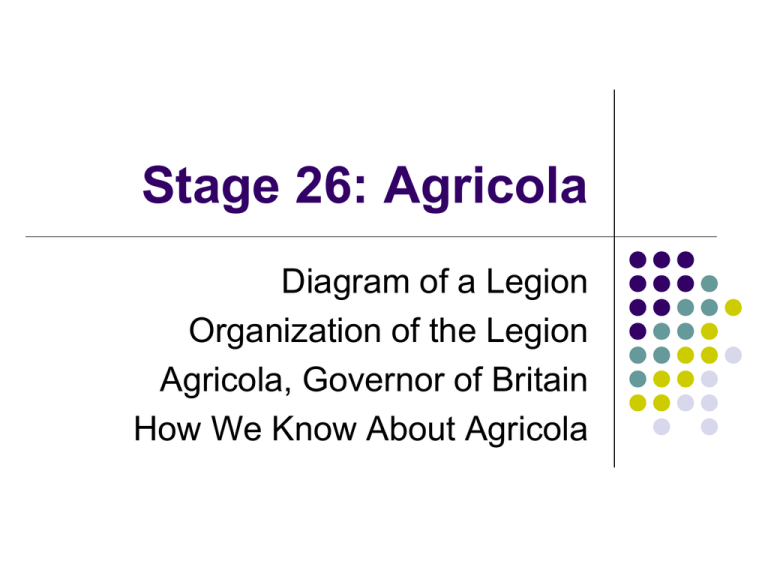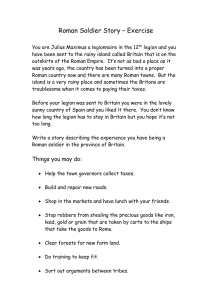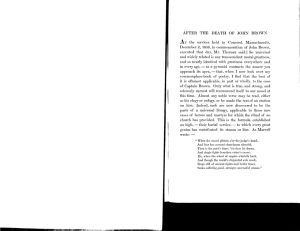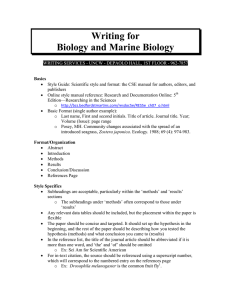Stage 26: Agricola Diagram of a Legion Organization of the Legion
advertisement

Stage 26: Agricola Diagram of a Legion Organization of the Legion Agricola, Governor of Britain How We Know About Agricola Diagram of a Legion KEY T=tesserarius S=signifer C=cornicen (horn player) Each cohort had one of each of these. Each century had a centurion and an optio. Organization of the Legion A legion consisted of 10 cohorts-nine had 6 centuries (80 men each) led by a centurion The first cohort was the most prestigious unit and had 5 doubled centuries (160 men each) commanded by centurions of the first rank (primi ordines) Each centurion was assisted by an optio In each century there was also a signifer and a tesserarius Centurions Known as the backbone of the legion Promoted because of their longevity, courage, and ability There were 60 total who were responsible for the training and discipline of the century Each centurion carried a vitis to show rank and to punish his soldiers The most senior centurion in the legion was the primus pilus (at least 50 yrs old and had risen in the ranks) The primus pilus held office for one year and then could either retire or become the praefectus castrorum The Senior Officers legatus-officer commanding a legion, member of the Senate in Rome, in his mid thirties The legatus was assisted by 6 military tribunes: 1. tribunus laticlavius-young man of noble birth serving a military apprenticeship before a political career; may continue on to be a legatus for 3 or 4 years or continue a civilian life 2-6. tribuni angusticlavii-members of a slightly lower class (equites), in their mid thirties; usually able, wealthy, educated men aiming at important posts in the imperial administration; some returned later to command cavalry units Senior Officers cont’d. Senior officers only spent a short time in the army, unlike the centurions and legionaries. Had to rely on the centurions for advice, although because of the organization, their flaws did not hurt the operations of the army Some officers were promoted based on competency and became governors of provinces Agricola, Governor of Britain Gaius Iulius Agricola was born is 40 AD in the Roman colony of Forum Iulii (modern Frejus) in southeast Gaul Family and Education Family: Agricola’s father was made a senator by the emperor Tiberius, but later fell out of favor with the Emperor Gaius Caligula and was executed shortly after Agricola was born Education: went to school at Massilia (Marseille)-an educational and cultural center of southern Gaul; had a normal education of sons of upper class Roman families-public speaking and philosophy Military and Political Career Military Service: at 18 he served in the Roman army in Britain as a tribunus (58 to 62 AD); *he used that time to become familiar with the province and the soldiers were able to get to know him; *witnessed the revolt of Boudica in 60 AD and the realities of war Political Career: he continued a career in Rome from 62 AD until 70 AD where he was married to Domitia Decidiana; *in 70 AD he returned to Britain to take command of the Twentieth legion stationed at Viroconium (Wroxeter) which became undisciplined and troublesome; *his success was rewarded by a promotion to a governorship of Aquitania in Gaul (75 AD); *became a consul in Rome in 77 AD *78 AD he returned to Britain for a third time, as governor of the province Governorship Governorship: *completed the conquest of Wales against the Ordovices *fought a series of successful campaigns in Scotland with a culminating victory at Mons Graupius in the north of the Grampian mountains *extended the network of roads and forts across northern Britain *established the legionary fortress at Deva (Chester) Maps from the governorship of Agricola Romanization Agricola carried out an extensive Romanization program According to Tacitus “he encouraged individuals and helped communities to build temples, fora, and houses in the Roman style” and he made people realize that under good laws it was better to live at peace with the Romans than to rebel against them. Tacitus tells of his education improvement plan: Agricola arranged for the sons of British chiefs to receive a broad education. He made it clear that he preferred the natural abilities of the British to the skill and training of the Gauls. As a result, instead of hating the language of the Romans, they became eager to learn it. After the Governorship Agricola was governor of Britain for 7 years (longer than any other imperial Roman governor) He accomplished the circumnavigation of Britain and the area under Roman control was almost doubled Agricola was recalled from Britain in 85 AD because his successes outshone the Emperor Domitian's own modest victories in Germany Back in Rome, Agricola was given the honors of a successful general-a statue and citation He retired into private life on his family estates in Gallia Narbonensis until his death in 93 AD at age 53 How We Know About Agricola His biography, the De vita et moribus Iulii Agricolae, was the first published work of his son-in-law, the historian Tacitus, and is the source for most of what is known about him. An inscription was found on a lead pipe at Chester which showed that the pipe was made in 79 AD, when Vespasian and Titus were consuls and Agricola was governor of Britain An inscription was also found in the forum of Verulamium but it is very fragmented. DEFINITIONS Primi ordines-first rank senior centurions Optio-The main function of an Optio was as an Optio centuriae, the second-in-command of a centuria Signifer-the standard bearer who carried the military emblem of that unit. It was composed of a number of philarae (disks), along with a number of other elements mounted on a pole, topped with a leaf-shaped spear head or a manus (human hand) image. It sometimes included a representation of a wreath, probably denoting an honor or award. Tesserarius-was a soldier in the Roman army who organized the guards and was responsible for getting the watch words (passwords) from the commander and seeing that it was kept safe Vitis-a symbol of the rank of centurion, a cane which was used to punish soldiers Primus pilus-most senior centurion of the legion who was at least 50 years old and had worked his way up through the various grades of centurion DEFINITIONS cont’d Praefectus castrorum-commander of the camp, highest ranking officer to serve his entire career in the army Legatus-officer commanding a legion, member of the Senate in Rome, in mid thirties Tribunus laticlavius-senior tribune with a broad stripe who was a young man of noble birth, serving his military apprenticeship before starting a political career Tribuni angusticlavii-tribunes with the narrow stripe; members of the equites and in their thirties Equites-The equites were the Roman middle class between the upper class of patricians and the lower class of plebians. The distinguishing mark of the equestrian class was a gold ring (that of the patrician was of iron) and narrow black band on the tunic. Tribunus-a title shared by 2–3 elected magistracies; derived originally from the representatives of the tribes (tribus) into which the Roman people were divided for military and voting purposes




